laura marling i speak because i can photo live album review new second

Sometimes I can imagine a Laura Marling height chart on my wall. I’ve seen her as just a girl, viagra order the fresh-faced ponytailed pinnacle of the human pyramid she posed in for her first feature in Amelia’s Magazine way back in Issue 5 (always the first to spot them, this right?). And I can still see her later, when she cut it to the blonde elfin crop that accompanied the release of debut album ‘Alas I Cannot Swim’ and her relentless touring of festivals across the country. Now my height chart is nearing completion as Marling stands proud, and newly brunette, one foot firmly in womanhood with the release of ‘I Speak Because I Can’.
She’s come far in a short time but in a seemingly alternative parallel to a Disney teen queen (though with much less terrifying results), matured with a spotlight fixed on her. God forbid anyone should see the diary of my seventeen year-old self, let alone find it encapsulated on record forever. Was Marling’s choice to leave a song as popular as “New Romantic” off her debut, with its naturally youthful realism but occasionally awkward heartbreak over the guy that was ‘really fit’, her own attempt to leave the past behind? Despite audience calls for a live rendition, Marling has seldom appeased them. A stoic and determined diminutive figure would instead pick up her guitar and let silence fall as she let the charms of ‘Alas I Cannot Swim’ wash over eager spectators. Standout efforts such as “Ghosts” and “Cross Your Fingers” showcased Marling’s capacity for creating songs that proved that a soft combination of pop and folk were a winning formula. Their galloping rhythms and sweet melodies were the perfect accompaniment for Marling’s now more abstract musings on matters of the heart, whilst her earthy, mesmerising voice drew comparisons to a younger Joni Mitchell and her ability to knit together the rhyme of her lyrics with such ease had you drawn in in a matter of minutes.
The accompanying success for such achievements could have easily short circuited the minds of most eighteen-year-olds. But Marling seems to be cut from a different cloth. The interim between releases saw Marling retreat from the so-called nu-folk scene dominated by artists such as Emmy the Great, Johnny Flynn and Noah & the Whale (her former band fronted by former boyfriend Charlie Fink) and begin work on a record that would mark her out among her contemporaries. ‘I Speak Because I Can’ does not necessarily have the same bouncy singalong charm of its predecessor but is a darker offering that shows Marling’s growth into an assured and headstrong artist.
Seemingly rising from the ground in a chatter of instruments tuning themselves to a perfect pitch, and faraway, fleeting glimpses of swelling calls, shouts and whispers are the heady introduction to “Devil’s Spoke”, the album opener. The stamping, hearty rhythm thunders with the power of Marling’s guitar, banjo and a booming devilish voice that proves Marling is truly the new powerhouse of her folk scene. “Devil’s Spoke” is a thundering overture that whips you into its whirlwind and is a perfect preamble to Marling’s adventures in her riveting world rich with images of lush English countryside and folklore tales. She hasn’t lost her touch for soaring vocals even amongst the rattle and hum grittiness, but as she advocates the curious joy of, “ripping off each other’s clothes in a most peculiar way,” we come to realise that the Marling on ‘I Speak Because I Can’ has learnt a few new things at the University of Life.
Marling doesn’t necessarily ever make it easy to work out what she’s saying; her imagery floats among a menagerie of characters, times and places all inextricably bound by the eternal dilemma of the feminine. With a transcendental quality akin to the writings of Virginia Woolf, Marling leads us from the damaged but resilient daughters (“Hope in the Air”) to the recovering lovelorn (“Rambling Man”). Her stories seem timeless in the context of her wholesome, charming melodies and bewitching lyricism. The strength of her strumming guitar beats out her message that, “I was who I am,” throughout “Rambling Man”, a song which seems to be the next evolution of Marling, the same strapping echoes of riffs, tumbling banjos and female vocals but with a more robust outlook that doesn’t seem to wallow in the helpless naivety that ‘Alas I Cannot Swim’ tended towards. Plucked strings and tiptoe basslines give way to a ritualistic waltzing on “Alpha Shallows” and a woman who lets her words fly out in the pronouncement that she, “wants to be held by those arms”. Meanwhile, “Hope in the Air” presents Marling as our very own Sister Grimm, her song rising from a murky water of booming piano and plump ominous notes spilling from her guitar: “There is a man that I know/Seventeen years he never spoke/Guess he had nothing to say.” Marling’s voice rises in a battle cry for the losing battle of female emancipation, “There’s hope in the air/There’s hope in the water/But no hope for me, your last serving daughter”, that presents a dramatic urgency to her troubles. It can all seem a tad too much but if you let yourself become susceptible to the hypnotic and transportive quality of Laura Marling then you are, for a few minutes, taken somewhere else.
“Made by Maid” is a fine canvas for Marling to spread her art upon; a simple guitar that twists and turns on itself and her own silky but deceptively deep voice are the only tools she needs to showcase a talent that has come so far in the little time we have known her. A track that will undoubtedly become a cornerstone of Marling’s gorgeous live performances, “Made by Maid” is a touching postcard from the heart, floating through woods, river and from birth in a sweeping ride through the pastoral imagination. “Goodbye England (Covered in Snow)” takes us on the same trajectory in proud display of strong violins, gentle and delicately placed piano and bass that seems to melt the chill of the picture Marling paints. More hopeful and a nod to the fast-paced lyricism of the girl of the past, she lets her voice dip and soar over chipping riffs like a springtime bird. Similarly, “Blackberry Stone” is a chance for Marling to take centre stage to scorn those who, “never let her be.” A fluttering guitar and long warble of the violin back her add a delicacy and gentle hum to a story of sadness but smouldering, eternal strength.
Don’t worry though, Marling hasn’t entirely turned her back on the shimmering and catchy melodies that earned her a significant fan base; penultimate track “Darkness Descends” is a bouncy summer bike ride that you can ‘ohh’ and ‘ahh’ to in all the right places. Perhaps not entirely letting her hair down, Marling keeps a rein on things as, “the sun comes up…too bright for me,” but lets the pace slip back and forth at a rate that can only invite your toes to start tapping.
The title itself, ‘I Speak Because I Can’ is a statement of Marling’s headstrong autonomy and independence. Solitary reflection is the impetus of her new music rather than any kind of inflated sense of self associated with the kind of appraise Marling has received in recent years. Mercury Prize-nominated and a darling of the music press, Marling had every opportunity to produce an album that capitalised on the expectant audience clutching at the straws of ‘Alas I Cannot Swim’. Marling is brave for releasing a darker, reflective and at some points polemic album such as ‘I Speak Because I Can’, but this move can only help cement her reputation as a stalwart of English folk. Her delicate birdlike nature has bolstered itself to a heady mix of feminine charm and attack; she still has the gentle appeal but there’s suddenly a lot more substance. In her final incarnation and title track of the album Marling becomes the author of the retelling of the Greek tale of Odysseus and his wife, her imagination and ability to traverse time and space allows her to maintain a perceptive and warm comment on the most eternal of situations: heartbreak. Whilst ‘I Speak Because I Can’ showcases the same beguiling markings of her previous effort, Marling presents a record to be proud of because of its differences, its refusal to play to formula and its explosive creative expression. Perhaps part of me will miss the breathless rhymes and skippy beats but Marling was always going to grow up. Never giving too much away and trying on a variety of different personas, ‘I Speak Because I Can’ is proof that despite the long, sometimes painful and sadly always public journey, Marling has found a place in her powerfully evocative imagination to let us sit comfortably for a while and listen to what she has found.

Sometimes I can imagine a Laura Marling height chart on my wall. I’ve seen her as just a girl, approved the fresh-faced ponytailed pinnacle of the human pyramid she posed in for her first feature in Amelia’s Magazine way back in Issue 5 (always the first to spot them, help right?). And I can still see her later, ed when she cut it to the blonde elfin crop that accompanied the release of debut album ‘Alas I Cannot Swim’ and her relentless touring of festivals across the country. Now my height chart is nearing completion as Marling stands proud, and newly brunette, one foot firmly in womanhood with the release of ‘I Speak Because I Can’.
She’s come far in a short time but in a seemingly alternative parallel to a Disney teen queen (though with much less terrifying results), matured with a spotlight fixed on her. God forbid anyone should see the diary of my seventeen year-old self, let alone find it encapsulated on record forever. Was Marling’s choice to leave a song as popular as “New Romantic” off her debut, with its naturally youthful realism but occasionally awkward heartbreak over the guy that was ‘really fit’, her own attempt to leave the past behind? Despite audience calls for a live rendition, Marling has seldom appeased them. A stoic and determined diminutive figure would instead pick up her guitar and let silence fall as she let the charms of ‘Alas I Cannot Swim’ wash over eager spectators. Standout efforts such as “Ghosts” and “Cross Your Fingers” showcased Marling’s capacity for creating songs that proved that a soft combination of pop and folk were a winning formula. Their galloping rhythms and sweet melodies were the perfect accompaniment for Marling’s now more abstract musings on matters of the heart, whilst her earthy, mesmerising voice drew comparisons to a younger Joni Mitchell and her ability to knit together the rhyme of her lyrics with such ease had you drawn in in a matter of minutes.
The accompanying success for such achievements could have easily short circuited the minds of most eighteen-year-olds. But Marling seems to be cut from a different cloth. The interim between releases saw Marling retreat from the so-called nu-folk scene dominated by artists such as Emmy the Great, Johnny Flynn and Noah & the Whale (her former band fronted by former boyfriend Charlie Fink) and begin work on a record that would mark her out among her contemporaries. ‘I Speak Because I Can’ does not necessarily have the same bouncy singalong charm of its predecessor but is a darker offering that shows Marling’s growth into an assured and headstrong artist.
Seemingly rising from the ground in a chatter of instruments tuning themselves to a perfect pitch, and faraway, fleeting glimpses of swelling calls, shouts and whispers are the heady introduction to “Devil’s Spoke”, the album opener. The stamping, hearty rhythm thunders with the power of Marling’s guitar, banjo and a booming devilish voice that proves Marling is truly the new powerhouse of her folk scene. “Devil’s Spoke” is a thundering overture that whips you into its whirlwind and is a perfect preamble to Marling’s adventures in her riveting world rich with images of lush English countryside and folklore tales. She hasn’t lost her touch for soaring vocals even amongst the rattle and hum grittiness, but as she advocates the curious joy of, “ripping off each other’s clothes in a most peculiar way,” we come to realise that the Marling on ‘I Speak Because I Can’ has learnt a few new things at the University of Life.
Marling doesn’t necessarily ever make it easy to work out what she’s saying; her imagery floats among a menagerie of characters, times and places all inextricably bound by the eternal dilemma of the feminine. With a transcendental quality akin to the writings of Virginia Woolf, Marling leads us from the damaged but resilient daughters (“Hope in the Air”) to the recovering lovelorn (“Rambling Man”). Her stories seem timeless in the context of her wholesome, charming melodies and bewitching lyricism. The strength of her strumming guitar beats out her message that, “I was who I am,” throughout “Rambling Man”, a song which seems to be the next evolution of Marling, the same strapping echoes of riffs, tumbling banjos and female vocals but with a more robust outlook that doesn’t seem to wallow in the helpless naivety that ‘Alas I Cannot Swim’ tended towards. Plucked strings and tiptoe basslines give way to a ritualistic waltzing on “Alpha Shallows” and a woman who lets her words fly out in the pronouncement that she, “wants to be held by those arms”. Meanwhile, “Hope in the Air” presents Marling as our very own Sister Grimm, her song rising from a murky water of booming piano and plump ominous notes spilling from her guitar: “There is a man that I know/Seventeen years he never spoke/Guess he had nothing to say.” Marling’s voice rises in a battle cry for the losing battle of female emancipation, “There’s hope in the air/There’s hope in the water/But no hope for me, your last serving daughter”, that presents a dramatic urgency to her troubles. It can all seem a tad too much but if you let yourself become susceptible to the hypnotic and transportive quality of Laura Marling then you are, for a few minutes, taken somewhere else.
“Made by Maid” is a fine canvas for Marling to spread her art upon; a simple guitar that twists and turns on itself and her own silky but deceptively deep voice are the only tools she needs to showcase a talent that has come so far in the little time we have known her. A track that will undoubtedly become a cornerstone of Marling’s gorgeous live performances, “Made by Maid” is a touching postcard from the heart, floating through woods, river and from birth in a sweeping ride through the pastoral imagination. “Goodbye England (Covered in Snow)” takes us on the same trajectory in proud display of strong violins, gentle and delicately placed piano and bass that seems to melt the chill of the picture Marling paints. More hopeful and a nod to the fast-paced lyricism of the girl of the past, she lets her voice dip and soar over chipping riffs like a springtime bird. Similarly, “Blackberry Stone” is a chance for Marling to take centre stage to scorn those who, “never let her be.” A fluttering guitar and long warble of the violin back her add a delicacy and gentle hum to a story of sadness but smouldering, eternal strength.
Don’t worry though, Marling hasn’t entirely turned her back on the shimmering and catchy melodies that earned her a significant fan base; penultimate track “Darkness Descends” is a bouncy summer bike ride that you can ‘ohh’ and ‘ahh’ to in all the right places. Perhaps not entirely letting her hair down, Marling keeps a rein on things as, “the sun comes up…too bright for me,” but lets the pace slip back and forth at a rate that can only invite your toes to start tapping.
The title itself, ‘I Speak Because I Can’ is a statement of Marling’s headstrong autonomy and independence. Solitary reflection is the impetus of her new music rather than any kind of inflated sense of self associated with the kind of appraise Marling has received in recent years. Mercury Prize-nominated and a darling of the music press, Marling had every opportunity to produce an album that capitalised on the expectant audience clutching at the straws of ‘Alas I Cannot Swim’. Marling is brave for releasing a darker, reflective and at some points polemic album such as ‘I Speak Because I Can’, but this move can only help cement her reputation as a stalwart of English folk. Her delicate birdlike nature has bolstered itself to a heady mix of feminine charm and attack; she still has the gentle appeal but there’s suddenly a lot more substance. In her final incarnation and title track of the album Marling becomes the author of the retelling of the Greek tale of Odysseus and his wife, her imagination and ability to traverse time and space allows her to maintain a perceptive and warm comment on the most eternal of situations: heartbreak. Whilst ‘I Speak Because I Can’ showcases the same beguiling markings of her previous effort, Marling presents a record to be proud of because of its differences, its refusal to play to formula and its explosive creative expression. Perhaps part of me will miss the breathless rhymes and skippy beats but Marling was always going to grow up. Never giving too much away and trying on a variety of different personas, ‘I Speak Because I Can’ is proof that despite the long, sometimes painful and sadly always public journey, Marling has found a place in her powerfully evocative imagination to let us sit comfortably for a while and listen to what she has found.

Basso & Brooke by Katie Harnett.
I was running late for this show due to the evil evil cocktails at the Laden Showrooms website launch party in the concrete house at the end of my street. (It’s on sale for £2.2 million. Nuts. I’ve been in there and it ain’t all that: it’s like the interior of a multi-storey carpark.)

The rooftop view from the house on Bacon Street, rx complete with poncey rainbow fibre optic light display.
As I hurtled into the courtyard of Somerset House I passed a girl I haven’t seen since I left the University of Brighton back in the mid 90s, so I sort of waved, aghast, at her. Inside I sat down next to a sniffy man who I once knew vaguely long ago, and who literally turned his nose up at me, and then turned his back. I don’t think I did smell but I probably was a little dishevelled. Cycling has a tendency to do that. I only spotted one other cyclist at the shows over the entire week. Funny that. But I tell you, it’s by far the quickest way to get between venues. Addison Lee eat your heart out.
I turned to the man on the other side of me, recognising in him a fellow twittering fiend as we tapped at our iphones (everyone in fashion has a blackberry), although god knows it was very hard to twitter from the official BFC tents because there was apparently very little 3G coverage. C’mon folks, sort it out! We formed an instant bond and swapped twitter addresses and I found out he runs the website Not Just a Label, bigging up young designers. Now that’s what I like, a spirit of camaraderie! And then I looked over and saw that beardy glam man was sat opposite me and that alone would have made my day. I’d love to know who he was – does anyone know? He even smiled at me during the show when he caught me looking at him rather than the clothes, and it made me tingle it did! He had the most elegant poise which I do so love. A couple of paps came strolling past me muttering about how they couldn’t be arsed to snap photos of the only sleb in the front row, the girl from the Noisettes, who is clearly not famous enough to earn a decent paycheck.

Basso & Brooke by Katie Harnett.
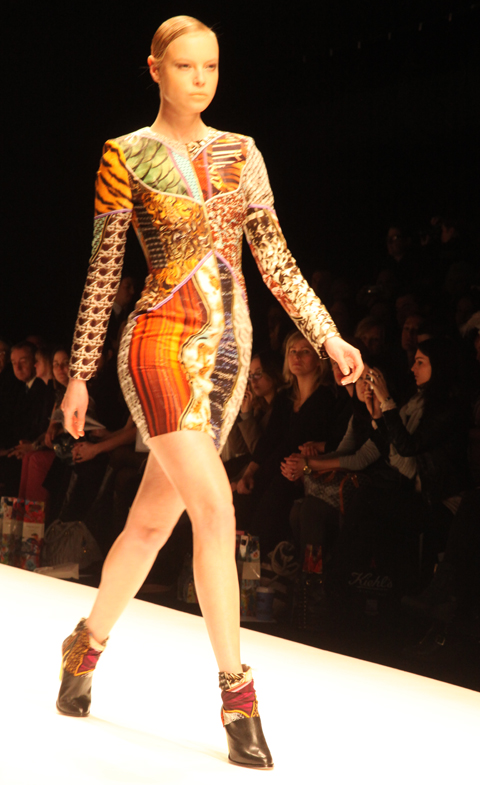

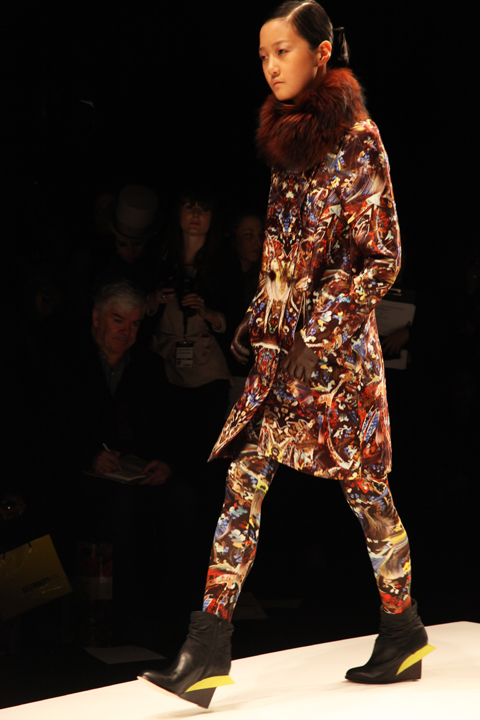

Basso & Brooke. All photography by Amelia Gregory.
On our seats were long elegant cardboard bottle carriers decorated in an exclusive Basso & Brooke print for the Turning Leaf wine company. These will no doubt make collector’s items in years to come so it’s a pity I have so much crap in my house already – where the hell would I display a wine bottle? Perhaps I could stick a candle in it and come over all studenty/70s? Or maybe not. But it did slip down easy, even if I had to lug it around for the rest of the day.
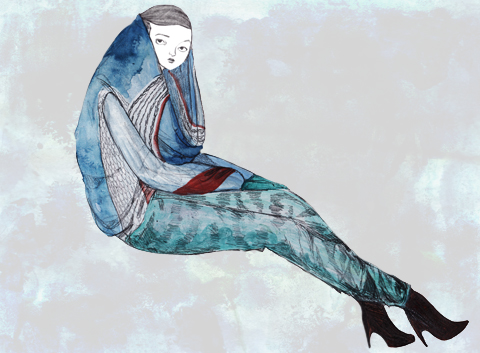
Basso & Brooke by Katie Harnett.

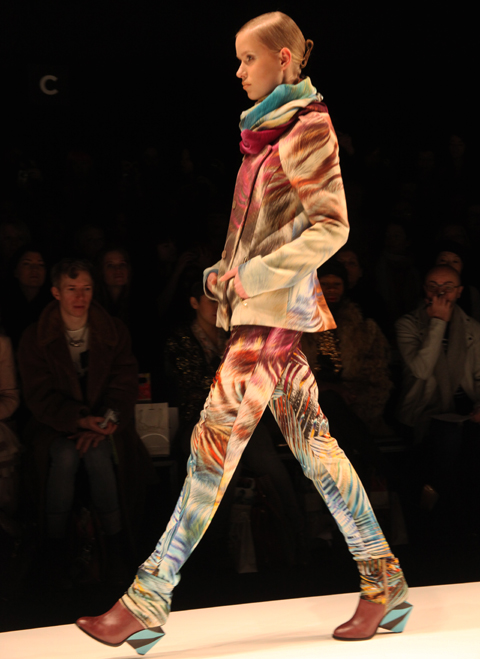
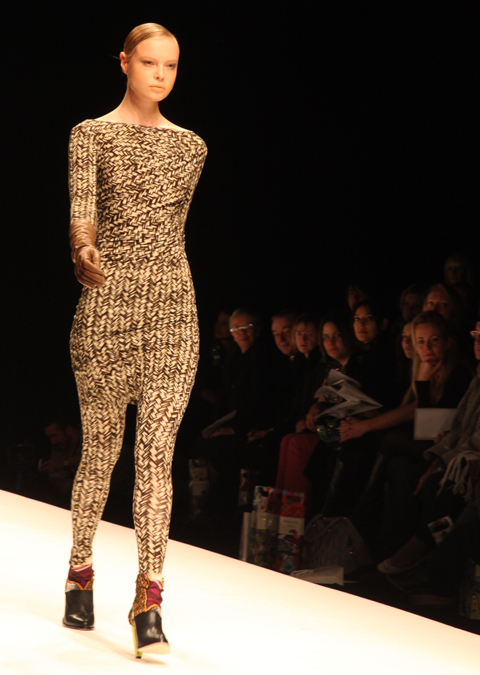
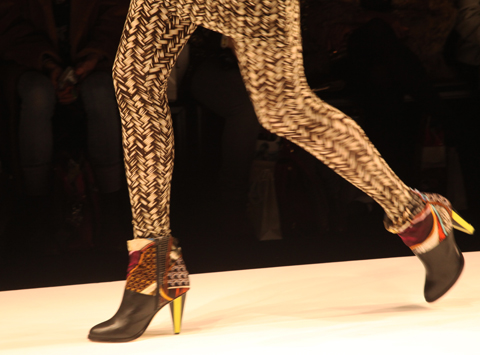
The Basso & Brooke show was as fabulous as it always is – but there you go, give me a riot of clashing prints and colour and I’ll swoon at your feet. Slinky body-hugging dresses, over equally slim clashing or matching leggings were covered in their signature digital prints – once unique but now used by many a designer – made the models lizard-like yet glamourous. A tough call that one but it worked. What didn’t work so well was the way they all moved, arms splayed and hands held awkwardly out. I can only conclude that they were all chosen for their singularly inelegant walks, or that they were all told to stride this way. Why?!
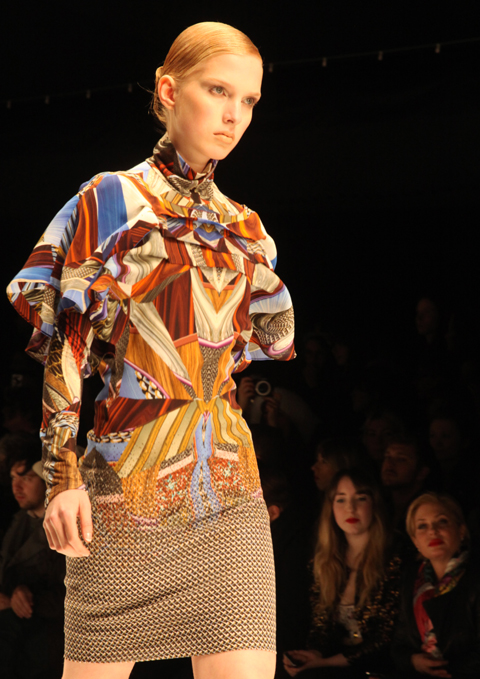
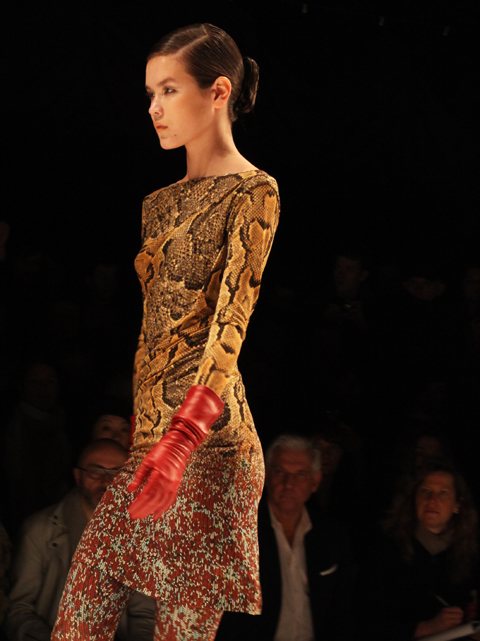
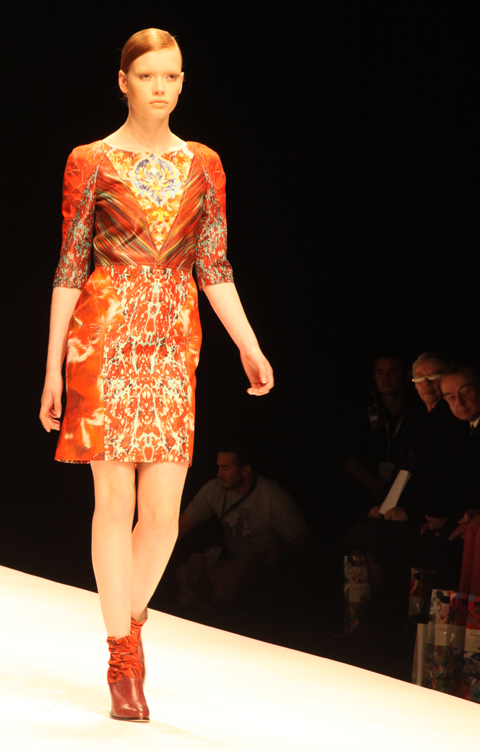



On leaving the show I bumped into my old college mate again, who was totally bemused by my presence at the shows. She was there purely in her capacity as senior designer at Monsoon “though I spend most of my time looking after my two kids these days.” She expressed surprise that I actually run Amelia’s Magazine, until she found out that I a childless. “Oh well that would explain it then. We used to keep those in the office for inspiration, I didn’t realise it was you.” What, not even with the prominent picture of me next to the introduction in every issue?

Basso & Brooke by Katie Harnett.
Isn’t it funny how people perceive you? (or don’t, as the case may be)

The designer interior of the Red Bull Music Academy by Gemma Milly.
Since the Red Bull Music Academy rolled into town just over a month ago I have been pursued by their PR to blog about the whole shebang. Unfortunately timings could not have been worse and whilst I have been concentrating on London Fashion Week the great and good of the electronic music world have been gathering in force to take part in this most singular of events. It therefore seems strangely fitting that I should finally publish my edit of the Steve Reich lecture that I attended on Tuesday 16th February on the very same day that it finally finishes.
If you live in London you cannot have escaped the presence of the Red Bull Music Academy, salve mainly in the form of their lovingly produced daily newspaper, page the Daily Note, which has been handed out at tube and train stations across London with the same zeal as the Evening Standard every single day since it started. I absolutely cannot begin to imagine how much it must have cost to assemble the staff to put together such a fast turnaround daily paper, let alone pay the folk that stand around in the street to hand it out.

Inside a recording studio in the Red Bull Music Academy. I’ve got that G-Plan coffee table in my living room. Cost a tenner at a car boot sale.
All interior photos courtesy of Red Bull.
The amount spent on producing the Daily Note must pale into insignificance when compared with how much money has been poured into the actual Red Bull Music Academy itself – which is a mammoth venture that rolls into a different country every year. This isn’t just a fancy name for a bunch of club nights that the general public can attend (though it is that too), but does exactly what it says on the tin and is an actual academy where actual students can learn from the maestros of electronic music. Sixty carefully selected students from across the world have been whisked into central London, where they’ve been given free accommodation and food for the duration of their stay. At the academy, which is located in the Red Bull headquarters a stone’s throw from the London Dungeon in Bermondsey, they are treated to an amazing roster of talks and tutorials laid on by eminent musicians, producers, DJs and composers, all apparently giving their time for free to further the education of this talented bunch. The emphasis is on electronic and urban music, and on genres which are not usually championed by the establishment, so most of the names featured in the bulging programme will not be familiar to anyone but the geekiest music bod within that particular musical subcategory.
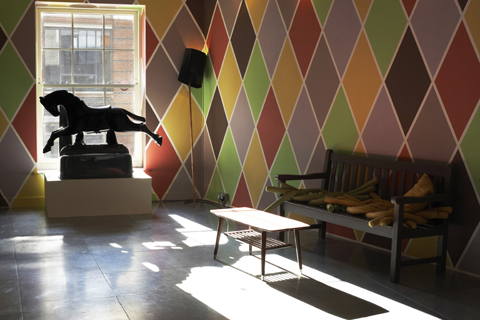

The amount of effort, let alone the money, that has been put into this venture is literally staggering. In the designer-decorated headquarters the skeletal office staff have been shunted into the top floors and the bottom few have been converted into something that would not look out of place on a reality show – featuring trendy young things lounging on plush sofas next to speccy music impresarios, a sparkling free cafe, pristine recording suites and buzzing glass walled rooms full of earnest Red Bull Music Academy staff. It is hard to fathom why such a big brand would so entirely align themselves with such a niche sub genre of music, but then this has got to be the most epic “anti-marketing” campaign I’ve ever known. Because no matter how lovingly those Daily Notes are put together I can’t believe many are actually more than skim read by some knackered commuter, and the vast majority will no doubt have been tossed straight into the bin by the mass public who just doesn’t care about this event or the music it champions. Will the Red Bull Music Academy, the busy events schedule or the Daily Note increase sales of Red Bull? Who knows, but for those lucky enough to be taking part as academy students it is surely a life changing opportunity.

bRUNA creating live music with a laptop.
It has to be said that the vast catalogue of acts involved aren’t really my cup of tea – I veer somewhat more on the indie side of life – but I decided to go along to the Sonar Pt 1 taster at the Roundhouse on Friday 5th March, where I then struggled to find something suited to my decidedly more indie/dance tastes. Upstairs what I heard as boos for the headline act were actually calls for hip hop legend Doom. DOOM! Downstairs I discovered something much more to my liking in the form of Red Bull Academy graduate bRUNA, a former lawyer from Spain. Unfortunately he wasn’t exactly what the earnest hip-hop heads had came for and the small room soon emptied. When I stayed on with my male partner bRUNA’s concerned girlfriend came over to check whether we really were there because we liked bRUNA’s cute Euro electro (we did). Or I should say: she came over and checked in with Tim. How funny that sexism should rear it’s ugly head in such a setting. Such was my ire that I did say to her pointedly – actually it’s me you want to be talking to.
I have only recently been inducted into the wonders of Steve Reich, but the event that looked most up my street was a lecture by this influential composer. And so it was that I found myself in the lecture theatre of the Red Bull Music Academy on a very rainy Tuesday afternoon. Read on to find out what Steve Reich revealed to his students…
Categories ,Bermondsey, ,bRUNA, ,Daily Note, ,Doom, ,Electronic music, ,electronica, ,G-Plan, ,Hip-hop, ,Lecture, ,Red Bull Music Academy, ,Roundhouse, ,Sonar, ,spain, ,Steve Reich
Similar Posts:
- Red Bull Music Academy: Steve Reich Lecture on Tuesday 16th February 2010
- Red Bull Music Academy: Steve Reich lecture Q&A from students
- Digitonal: Beautiful Broken – an interview with Andy Dobson
- Art Listings
- Clayton Strange – Interview



